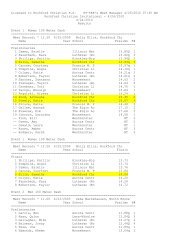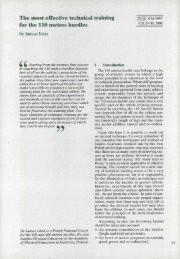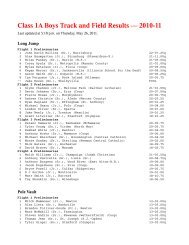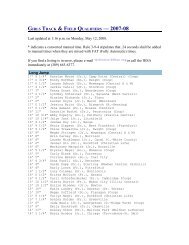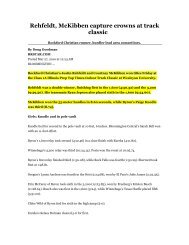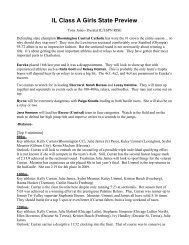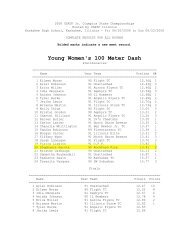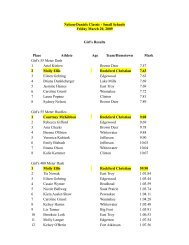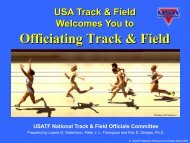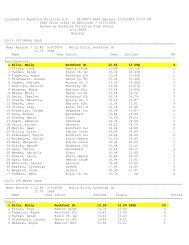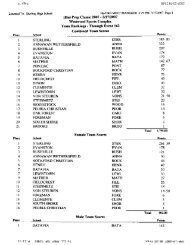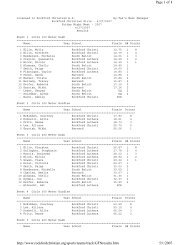kinematic analysis of hurdling performances at 2000 united states ...
kinematic analysis of hurdling performances at 2000 united states ...
kinematic analysis of hurdling performances at 2000 united states ...
Create successful ePaper yourself
Turn your PDF publications into a flip-book with our unique Google optimized e-Paper software.
KINEMATIC ANALYSIS OF HURDLING PERFORMANCES AT <strong>2000</strong> UNITED STATES<br />
OLYMPIC TRIALS<br />
Alfred Finch 1 , Gideon Ariel 2 , and John McNichols 1<br />
1<br />
Indiana St<strong>at</strong>e University, Terre Haute, IN USA<br />
2<br />
Ariel Dynamics, Inc., San Diego, CA USA<br />
Video images <strong>of</strong> the third hurdle clearance by the finalists in the Men’s 110 m hurdles <strong>at</strong> the United<br />
St<strong>at</strong>es Olympic Trials were recorded from 3 camera views. Temporal and <strong>kinem<strong>at</strong>ic</strong> variables were<br />
calcul<strong>at</strong>ed from the film records for the 4 competitors whose hurdle clearances were unobscured out <strong>of</strong><br />
the 8 competitors. The mean foot contact time during the take-<strong>of</strong>f was .142 s and the average flight time<br />
was .317 s. The hurdlers increased their horizontal velocity <strong>of</strong> the CM during the take-<strong>of</strong>f stride by 13<br />
cmhsec -1 and they increased their horizontal velocity <strong>of</strong> the CM <strong>at</strong> landing by 84.8 cmhsec -1 . The<br />
hurdler elev<strong>at</strong>ed their CM from the take-<strong>of</strong>f by 11.6 cm during hurdle clearance and a peak rise <strong>of</strong> 14.7<br />
cm for the body’s CM was found <strong>at</strong> peak elev<strong>at</strong>ion. The apex <strong>of</strong> the flight trajectory occurred on the<br />
average 3.2 cm before the hurdle and the hurdler left the ground 224 cm before the hurdle and landed<br />
143 cm behind the hurdle. Integr<strong>at</strong>ed multimedia analyses <strong>of</strong> their <strong>hurdling</strong> <strong>performances</strong> were presented<br />
<strong>at</strong> the USATF Elite <strong>hurdling</strong> development camp.<br />
KEY WORDS: <strong>kinem<strong>at</strong>ic</strong> <strong>analysis</strong>, Elite hurdlers, Olympic Trials<br />
INTRODUCTION: The purposes <strong>of</strong> this project were to collect video records <strong>of</strong> elite high hurdlers<br />
during the <strong>2000</strong> United St<strong>at</strong>es Olympic Trials, <strong>kinem<strong>at</strong>ic</strong>ally analyze their performance, and<br />
immedi<strong>at</strong>ely review the <strong>hurdling</strong> technique with the <strong>at</strong>hletes/coaches using an integr<strong>at</strong>ed multimedia<br />
present<strong>at</strong>ion approach. This project’s objectives were supported by the United St<strong>at</strong>es Track and Field<br />
Hurdling Development committee for the identific<strong>at</strong>ion and further development <strong>of</strong> the elite hurdlers<br />
particip<strong>at</strong>ing <strong>at</strong> the Olympic Trials. Hurdling is a specialized form <strong>of</strong> sprinting th<strong>at</strong> requires the<br />
clearance <strong>of</strong> a series <strong>of</strong> hurdles. The goal <strong>of</strong> sprinting is to cover the distance in the shortest time<br />
possible, in may be concluded th<strong>at</strong> an <strong>at</strong>hlete’s success in the event may be influenced by their ability to<br />
produce the gre<strong>at</strong>est horizontal velocity. To produce high horizontal velocities it is necessary to produce<br />
large amounts <strong>of</strong> horizontal force while in contact with the ground. Therefore, the horizontal force<br />
applied may be expressed by the following formula:<br />
Horizontal Force = Mass • ( ∆Horizontal Velocity) • Ground Time -1<br />
METHODS: Video records <strong>of</strong> 8 Elite high hurdlers were taken <strong>at</strong> 60 Hz from two front right and<br />
sagittal perspectives as they cleared the third hurdle during the high hurdle finals <strong>of</strong> the <strong>2000</strong> United<br />
St<strong>at</strong>es Olympic Team Track and Field Trials (See Figure 1).
Only 4 hurdlers’ <strong>performances</strong> were digitized due to obscured views as the flight passed over the hurdle.<br />
Fourteen body d<strong>at</strong>a points, 6 hurdle points (right & left top, base, & standard base), and the fixed<br />
reference marker on the video images <strong>of</strong> the hurdle trials were digitized, the coordin<strong>at</strong>e d<strong>at</strong>a were scaled<br />
using an 3-DLT transform<strong>at</strong>ion, and then smoothed using a quintic spline filter. To examine the<br />
rel<strong>at</strong>ionships between horizontal force production, contact time, and flight time, the temporal variables<br />
<strong>of</strong> foot contact time during the stride prior to take-<strong>of</strong>f and flight time were determined. Kinem<strong>at</strong>ic d<strong>at</strong>a<br />
included the changes in CM horizontal velocity during foot contact <strong>at</strong> take-<strong>of</strong>f, changes in CM<br />
horizontal velocity <strong>at</strong> landing after hurdle clearance, vertical elev<strong>at</strong>ion <strong>of</strong> CM during hurdle clearance<br />
from take-<strong>of</strong>f, and horizontal displacement <strong>of</strong> the CM apex in comparison to hurdle clearance position.<br />
Additionally, the displacement <strong>of</strong> the foot <strong>at</strong> take-<strong>of</strong>f from the hurdle, and the displacement <strong>of</strong> the<br />
landing foot from the hurdle were determined (See Figure 2).<br />
Technique <strong>analysis</strong> <strong>of</strong> the video records were reviewed with the <strong>at</strong>hlete, his coach, and a member <strong>of</strong> the<br />
United St<strong>at</strong>es <strong>of</strong> America Track and Field (USATF) Elite <strong>hurdling</strong> development staff, the next day after<br />
the competition. Subsequent analyses using d<strong>at</strong>a integr<strong>at</strong>ion techniques <strong>of</strong> the hurdler’s video records,<br />
stick figure reconstruction with the CM traced, and the <strong>kinem<strong>at</strong>ic</strong> d<strong>at</strong>a graphs <strong>of</strong> their <strong>hurdling</strong> trials<br />
were gener<strong>at</strong>ed. These integr<strong>at</strong>ed multimedia displays are to be provided to the <strong>at</strong>hletes <strong>at</strong> the USATF<br />
Elite Hurdling Development camp to be held <strong>at</strong> the United St<strong>at</strong>es Olympic Committee Training facility<br />
in Chula Vista, California (See Figure 3).
RESULTS AND DISCUSSION: Means and standard devi<strong>at</strong>ions <strong>of</strong> the temporal and <strong>kinem<strong>at</strong>ic</strong> d<strong>at</strong>a <strong>of</strong><br />
the elite high hurdlers’ <strong>performances</strong> <strong>at</strong> the <strong>2000</strong> United St<strong>at</strong>es Track and Field Olympic Team Trials<br />
were calcul<strong>at</strong>ed and are presented in Table 1.<br />
Table 1. Temporal & <strong>kinem<strong>at</strong>ic</strong> d<strong>at</strong>a for <strong>2000</strong> Olympic Trials - 110m hurdles<br />
Variable D. Wallace A. Johnson L. Wade T. Dees Mean SD<br />
Contact Time .150 .133 .133 .150 .142 .010<br />
s<br />
Flight Time s .333 .302 .300 .333 .317 .018<br />
Hor CM Vel. 52.0 49.0 -69.0 20.0 13.0 56.5<br />
Take-<strong>of</strong>f<br />
cm/s<br />
Hor CM Vel. -33.5 9.3 180.1 183.3 84.8 113.3<br />
Landing<br />
cm/s<br />
CM 1.0 9.2 21.4 14.9 11.6 8.6<br />
Elev<strong>at</strong>ion <strong>at</strong><br />
Clearance<br />
CM Vertical 5.7 12.2 22.8 18.0 14.7 7.4<br />
Displacement<br />
cm<br />
CM Apex -34.9 -17.2 0.6 38.8 -3.2 31.5<br />
Hor<br />
Displacement<br />
cm<br />
Take-<strong>of</strong>f 261.0 218.1 210.8 208.3 224.6 24.7<br />
Displacement<br />
cm<br />
Landing<br />
Displacement<br />
cm<br />
95.8 174.9 164.3 140.2 143.8 35.1<br />
The mean foot contact time calcul<strong>at</strong>ed for the step going into the hurdle for this study’s elite high<br />
hurdlers were slightly faster than the 0.135 s contact times reported by R. Mann (1993) in the Elite<br />
Hurdler Project technical report. But these values were slightly slower than the .122s foot contact times<br />
for the American Elite hurdlers determined by Finch, Ariel & McNichols (<strong>2000</strong>). In the present study,<br />
the flight times were found to be similar to the .31 s flight times determined for the good elite hurdlers<br />
analyzed in the 1993 project and faster than the reported .366 s flight times determined <strong>at</strong> an American<br />
Elite Hurdling development camp. The shorter flight times may be <strong>at</strong>tributable to the present study’s<br />
elite level <strong>of</strong> training and the competitive n<strong>at</strong>ure <strong>of</strong> the Olympic Trials. The high hurdlers elev<strong>at</strong>ed their<br />
CM approxim<strong>at</strong>ely 11.6 cm <strong>at</strong> hurdle clearance above their CM position <strong>at</strong> take-<strong>of</strong>f during the <strong>hurdling</strong><br />
movement and they <strong>at</strong>tained a peak CM height <strong>of</strong> 14.7 above their CM take-<strong>of</strong>f position. The high<br />
hurdlers’ horizontal displacements between the apex <strong>of</strong> the CM trajectory and the hurdle ranged from<br />
34.9 cm in front <strong>of</strong> the hurdle to 38.8 cm after the hurdle. The hurdlers’ mean horizontal displacement<br />
<strong>of</strong> the apex was 3.2 cm before the hurdle. Therefore some <strong>of</strong> the hurdlers need to work on their strides<br />
going to the hurdle and the CM projection trajectory, in order to make their CM flight trajectory apex
coincide with the hurdle clearance position r<strong>at</strong>her than in front. If this alignment <strong>of</strong> the trajectory peak<br />
was made then the hurdlers would not need to produce as gre<strong>at</strong> an elev<strong>at</strong>ion and shorter flight times<br />
would result. Only, one <strong>of</strong> the high hurdlers’ CM peak trajectories coincided with the hurdle clearance.<br />
The hurdlers’ average take-<strong>of</strong>f distance was 224.6 cm and their landing distance was 143.8 cm. These<br />
displacements were very close to the 213 cm (7 ft) take-<strong>of</strong>f and 122 cm (4 ft) landing displacements, th<strong>at</strong><br />
are typically discussed by hurdle coach clinicians. The alter<strong>at</strong>ions in the horizontal velocities <strong>of</strong> the CM<br />
during the take-<strong>of</strong>f found th<strong>at</strong> the high hurdlers increased their velocity by 13 cmhsec - 1 or<br />
approxim<strong>at</strong>ely 1% <strong>of</strong> their running velocity. These acceler<strong>at</strong>ive changes in the horizontal velocities for<br />
the hurdlers would be indic<strong>at</strong>ive <strong>of</strong> an appropri<strong>at</strong>e stride length foot <strong>at</strong> foot plant prior to take-<strong>of</strong>f.<br />
During the landing phase, the hurdlers experienced an acceler<strong>at</strong>ion <strong>of</strong> 84 cmhsec -1 or about 7.6% <strong>of</strong><br />
their running velocity, as they came over <strong>of</strong> the hurdle, which would be indic<strong>at</strong>ive <strong>of</strong> the hurdler landing<br />
in a tall running position r<strong>at</strong>her than settling and retarding their running velocity. The applic<strong>at</strong>ion <strong>of</strong><br />
gre<strong>at</strong>er horizontal forces would be indic<strong>at</strong>ed by shorter ground contact times and those horizontal forces<br />
may only be gener<strong>at</strong>ed when the hurdler is contact on the ground, therefore long flight times while<br />
clearing the hurdle would not be beneficial in achieving fast <strong>hurdling</strong> times. The small vertical CM<br />
displacements observed for the hurdlers during hurdle clearance indic<strong>at</strong>ed th<strong>at</strong> the hurdlers strode over<br />
the hurdle, thus reducing the flight time and increasing the acceler<strong>at</strong>ion <strong>of</strong> the body when in contact with<br />
the ground.<br />
CONCLUSIONS: The hurdlers experienced their gre<strong>at</strong>est acceler<strong>at</strong>ion during the landing phase after<br />
the hurdle clearance than the step prior to take-<strong>of</strong>f. Only one <strong>of</strong> the four hurdlers’ apex <strong>of</strong> their CM<br />
flight trajectory occurred over the hurdle. The hurdlers’ apex <strong>of</strong> their CM parabolic p<strong>at</strong>hway should<br />
occur while clearing the hurdle. A horizontal displacement between the CM apex and the hurdle would<br />
be indic<strong>at</strong>ive <strong>of</strong> improper striding or flight trajectories, where the take-<strong>of</strong>f step occurred too close or too<br />
far from the hurdle or they projected their body <strong>at</strong> an improper angle. An apex displacement would<br />
indic<strong>at</strong>e th<strong>at</strong> the hurdler reached his peak flight position either slightly before or after the hurdle. The<br />
simultaneous integr<strong>at</strong>ion <strong>of</strong> video, stick figures and d<strong>at</strong>a was used as a visual coaching and research tool<br />
for performing a hurdle <strong>analysis</strong> and providing immedi<strong>at</strong>e feedback to the <strong>at</strong>hlete and coach.<br />
REFERENCES:<br />
Finch, A., Ariel, G., & McNichols, J. (<strong>2000</strong>). Integr<strong>at</strong>ed <strong>kinem<strong>at</strong>ic</strong> d<strong>at</strong>a <strong>analysis</strong> <strong>of</strong> American elite<br />
hurdlers. In: Proceedings <strong>of</strong> Intern<strong>at</strong>ional Symposium on Biomechanics in Sports XVIII, The University<br />
<strong>of</strong> Hong Kong, Hong Kong, China.<br />
Mann, R. (1993). The mechanics <strong>of</strong> sprinting and <strong>hurdling</strong>. Elite Hurdler Project technical report.<br />
United St<strong>at</strong>es Track & Field Associ<strong>at</strong>ion, 1-135.<br />
McDonald, C., & Dapena, J. (1991). Linear <strong>kinem<strong>at</strong>ic</strong>s <strong>of</strong> the men’s 110-m and women’s 100-m<br />
hurdles races. Medicine & Science in Sports & Exercise, 23:1382-91.



